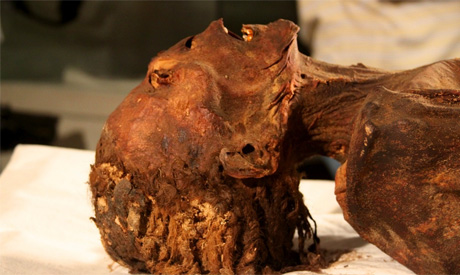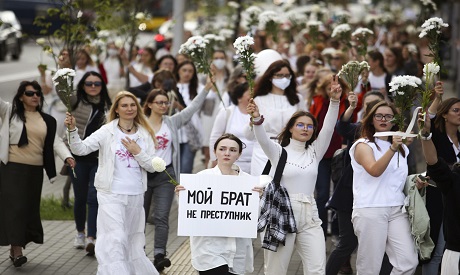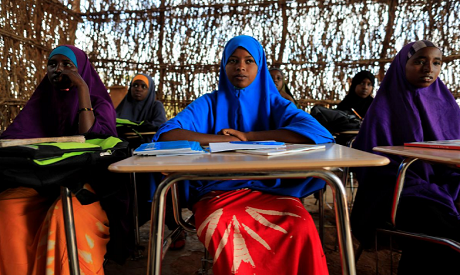Derechos are sometimes called "inland hurricanes" due to the extensive damage that they can cause and how they appear on radar images.
By definition, a derecho is a long-lived complex of intense thunderstorms that travels at least 250 miles. Additionally, wind gusts along its path must exceed 58 mph with at least several reports of gusts over 75 mph, according to the Storm Prediction Center.
By definition, a derecho is a long-lived complex of intense thunderstorms that travels at least 250 miles. Additionally, wind gusts along its path must exceed 58 mph with at least several reports of gusts over 75 mph, according to the Storm Prediction Center.
Aug. 12 (UPI) -- A powerful derecho that tore through the Midwest earlier this week also flattened more than 10 million acres of crops in Iowa, Gov. Kim Reynolds said.
Among the crops destroyed were about 43% of the state's corn and soybean yields.
"Although it will take days or weeks to know the full scope of damage, initial reports are significant," Reynolds said Tuesday.
More than 600,000 customers also remained without power in the region Wednesday after the derecho -- a fast-moving line of severe thunderstorms -- tore through the area earlier this week.
About 300,000 of those customers were located in Iowa, according to poweroutage.us, the state's three largest metropolitan areas of Des Moines, Cedar Rapids and Davenport continued to report widespread outages.
Two deaths have also been reported as a result of the storm including a 63-year-old bicyclist who was struck by a large falling tree and a 73-year-old woman who was found in a mobile home that was damaged by the derecho.
Reynolds said the storm resulted in more widespread damage than typical tornadoes and issued emergency declarations in 20 counties.
"It is just about across the entire state, very widespread and significant, significant damage has been done," she said.
Thunderstorms to continue Tuesday in the wake of powerful derecho
Provided by AccuWeather, Accuweather.com
AUG. 11, 2020
In the wake of a massive derecho that rolled across the Midwest on Monday, the same atmospheric disturbance will spark up additional rounds of heavy thunderstorms along its path into Tuesday night.
At the derecho's peak intensity, wind gusts in excess of 100 mph were observed across portions of eastern Iowa during the afternoon on Monday. Numerous reports of 70- to 90-mph wind gusts also brought along a wide swath of damage reports across northern Illinois, including the Chicago metro area as well.

Luckily, a thunderstorm complex of that magnitude is not expected for the second day in a row. However, AccuWeather meteorologists will be monitoring a few separate areas for severe thunderstorm activity once again.
Amid hot and increasingly humid conditions, portions of the interior Northeast and New England will be one area to closely monitor for the threat of potentially heavy thunderstorms.
Ahead of the storm system that will eventually trigger these storms across the Northeast, a southwesterly breeze will bring a surge of moisture northward, putting the fuel needed for explosive thunderstorm development in place.

Anyone with outdoor plans across portions of upstate New York, including Ithaca, Syracuse and across the Adirondacks, will want to have a secondary plan of action prepared just in case thunderstorms develop overhead. As the afternoon progresses, this threat will translate eastward.
It is possible that another complex, or broken line of thunderstorms could develop once again during the afternoon. This threat could extend from the Champlain Valley and much of interior New England, southwestward into northeastern Pennsylvania.
In similar fashion to the events on Monday -- although not nearly as intense -- damaging wind gusts and locally flooding downpours will be the primary concern from these thunderstorms. A few incidents of hail cannot be ruled out.
During the late-night hours, thunderstorm activity is expected to weaken somewhat as they approach the Interstate-95 corridor across the Northeast and New England.
In the wake of the thunderstorm activity across the Northeast, a brief reprieve of the heat will be in store for some across the interior.
Another area of potentially threatening weather into Tuesday evening from the same storm system will be along the trailing edges of the drier push of air across the middle and lower Mississippi River Valley.

Across this zone, plenty of atmospheric moisture will remain in place, providing fuel for potentially drenching thunderstorms. Areas from eastern Oklahoma, Arkansas, southern Missouri, Tennessee and northern Mississippi could come into play.
While locally severe wind gusts and hail are possible, the most expansive threat across this zone will be from heavy rain that could lead to flooding.
Mother Nature will be keeping busy across the country, as a threat for severe weather will unfold in another region of the country.
A weak disturbance at the jet stream level of the atmosphere will be streaking eastward out of the Rockies and into the High Plains, which will set the stage for explosive thunderstorm development into the evening hours.

Areas along and east of the I-25 corridor in Colorado and Wyoming will be first in line for this threat as storms erupt in the area. Large hail, damaging wind gusts and torrential rainfall rates will be possible here.
There may be enough atmospheric support in place across the northern portion of this zone for yet another complex of severe thunderstorms well after dark.
"The area from Mobridge, South Dakota, to North Platte, Nebraska, on east will be at greatest risk for severe weather after 10 p.m. local time Tuesday night.
This could prove dangerous for motorists traveling along I-90 in South Dakota overnight, as wind gusts could be strong enough to tip over high-profile vehicles.
A jet stream pattern conducive for a multi-day threat for severe weather will likely remain in place across the northern and central Plains in the coming days. While a derecho of the same caliber that was observed on Monday is not expected over the next few days, it cannot be completely ruled out.
upi.com/7028300
Derecho thunderstorms slam Chicago, leave devastation in Iowa
By
Brian Lada & Jean Lotus, Accuweather.com
AUG. 10, 2020

A derecho storm system with high-speed winds over 70 mph hit Chicago and northern Illinois Monday during evening rush hour. Image by National Weather
CHICAGO, UPI --
An intense line of storms known as a derecho developed over the central United States Monday, causing significant damage and widespread power outages as it blitzed eastward, striking Chicago during evening rush hour.
Thunderstorms ignited in southeastern South Dakota and eastern Nebraska on Monday morning, but gained strength and evolved into a derecho across central Iowa by midday. Winds between 70-100 mph were expected after the worst of the storms swept eastward through northern Illinois.
A tornado warning for Cook County another northern Illinois counties from the National Weather Service warned that 80 mph winds would pick up flying debris and be "dangerous to those caught without shelter."
Mobile homes may be heavily damaged, the weather service warned. "Expect considerable damage to roofs, windows, and vehicles. Extensive tree damage and power outages are likely," the weather service said.
High wind speeds were measured at 72 mph at Midway airport, the NWS said.
Earlier Monday, across Iowa, large trees, branches, debris and power lines littered streets and yards, with many residents finding themselves in the dark in the wake of the storms.
Over 400,000 were without power across Iowa alone as of early Monday afternoon, according to PowerOutage.us, including the entire town of Ames - and these numbers may continue to climb into the evening. Marshalltown, Iowa, has been one of the towns hit the hardest by the derecho and recorded a wind gust of 95 mph observed at the town's airport.
Major damage has been reported in Cedar Rapids, Iowa, the second-most populated city in the state. A wind gust of 100 mph was clocked in Hiawatha, which is just a few miles north of Cedar Rapids.
Derechos are sometimes called "inland hurricanes" due to the extensive damage that they can cause and how they appear on radar images.
By definition, a derecho is a long-lived complex of intense thunderstorms that travels at least 250 miles. Additionally, wind gusts along its path must exceed 58 mph with at least several reports of gusts over 75 mph, according to the Storm Prediction Center.
In 2012, a particularly strong derecho traveled 800 miles from the Midwest to the coast of the mid-Atlantic, causing $3 billion in damage and leaving some in the dark for days during the peak of summer heat.
This weather phenomenon not only looks like an 'inland hurricane' on radar it can feel like one too
While a derecho is a thunderstorm complex, it is its severity, distance and duration that make this weather phenomenon stand out from the more typical spring and summer storms.
The term derecho is derived from the Spanish language adverb which means "straight" in English. The term tornado in Spanish means "to turn."
Even though derechos can produce isolated tornadoes with twisting and turning winds, damage is most often similar to a thunderstorm downburst. Winds during a thunderstorm downburst tend to push and/or knock objects over, such as trees and power lines, in a straight line.
However, while damage from a thunderstorm downburst may occur over a few miles or less, the damage produced by a derecho occurs over a much more broad scale.

This radar image shows the complex of thunderstorms that was classified as a derecho as it swept form southeastern Ohio to West Virginia during the evening hours on Jun 29, 2012. (NOAA)
While a derecho may look like an inland hurricane on radar and satellite images and seem like the same in person with its combination of strong wind and torrential rain, the meteorological community has criteria that determines whether or not a thunderstorm complex has achieved the "d-word" level.
"The main consideration for a thunderstorm complex to be considered a derecho is if severe, damaging, straight-line winds have occurred along a continuous 240-mile-long path or greater," according to AccuWeather Senior Meteorologist Kristina Pydynowski.
"A derecho must include wind gusts of at least 58 mph or greater along most of its path," according to the Storm Prediction Center (SPC).
Fifty-eight miles per hour is the official cutoff for winds to be considered severe weather.
While there is no official designation for how wide a derecho must be, the family of thunderstorm complexes that produce derechos generally reach 50 miles or greater in width as described by SPC.
AccuWeather meteorologists will generally not refer to a complex of thunderstorms as a derecho unless there is significant concern for the aforementioned criteria being reached.
Some examples of famous, deadly and damaging derechos include the long-lived thunderstorm complex during the summer of 2012.

This image shows the list and location of severe weather reports from the derecho of June 29-30, 2012. There were more than 1,000 reports of damaging winds during the event. (Storm Prediction Center/NOAA)
The 2012 derecho had its beginnings over Iowa on June 29 and traveled approximately 800 miles to the mid-Atlantic coast on June 30.
Nearly two dozen people were killed and damage approached $3 billion during the June 2012 event.
More than 4 million utility customers lost power during the event as scores of trees came down and took power lines with them in the two-day span.

In this June 30, 2012, photo, an American Beech tree is down on Capitol Hill grounds in Washington, D.C., across from the U.S. Supreme Court after a derecho swept across the region. (AP/Manuel Balce Ceneta)
There have been dozens of derechos over the past four decades alone.
During July 11-15, 1995, four separate derechos occurred over the northern tier of the United States. Damage from the four events approached $1 billion.

This hand-drawn map shows the areal coverage of the four derechos that occurred spanning July 11-15, 1995 over the northern United States. (NOAA)
"Derechos and their parent thunderstorm complexes often form and move along the northern edge of a large rim of heat," Pydynowski said.
This is often the location of a strong jet stream overhead, which helps to not only give the storms more strength, but also causes them to move along at a swift pace.
While multiple complexes of thunderstorms often occur every week during the late spring and summer, those which reach the criteria of a derecho are significantly less common.

In addition to the U.S., derechos have been documented in Europe over the past few decades.
A derecho should not be confused with a squall line, which is a narrow zone of thunderstorms some of which may be severe.
A squall line forms along or ahead of a cold front and typically marks the end of warm or hot weather, according to SPC.
Squall lines can extend for 1,000 miles or more and travel similar distances in extreme cases.
During or after the passage of a derecho, heat may build, cooler air may follow or temperatures may remain nearly the same.

/cdn.vox-cdn.com/uploads/chorus_image/image/67184180/1227973594.jpg.0.jpg)
:no_upscale()/cdn.vox-cdn.com/uploads/chorus_asset/file/21715788/1227985983.jpg.jpg) Former candidate in the 2020 Belarusian presidential election Svetlana Tikhanovskaya during a press conference on the election results on August 10, 2020. Natalia Fedosenko/TASS/Getty Images
Former candidate in the 2020 Belarusian presidential election Svetlana Tikhanovskaya during a press conference on the election results on August 10, 2020. Natalia Fedosenko/TASS/Getty Images:no_upscale()/cdn.vox-cdn.com/uploads/chorus_asset/file/21715792/1222403538.jpg.jpg)
:no_upscale()/cdn.vox-cdn.com/uploads/chorus_asset/file/21714283/1227856293.jpg.jpg)









